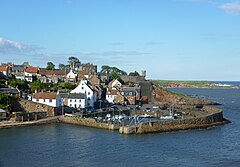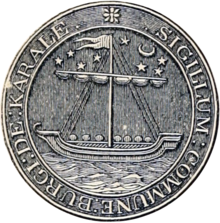This is an old revision of this page, as edited by Seasider53 (talk | contribs) at 23:33, 21 January 2022 (→Notable residents). The present address (URL) is a permanent link to this revision, which may differ significantly from the current revision.
Revision as of 23:33, 21 January 2022 by Seasider53 (talk | contribs) (→Notable residents)(diff) ← Previous revision | Latest revision (diff) | Newer revision → (diff)Human settlement in Scotland
Crail
| |
|---|---|
 | |
 | |
| Population | 1,630 |
| OS grid reference | NO613078 |
| Council area | |
| Lieutenancy area | |
| Country | Scotland |
| Sovereign state | United Kingdom |
| Post town | ANSTRUTHER. |
| Postcode district | KY10 |
| Dialling code | 01333 |
| Police | Scotland |
| Fire | Scottish |
| Ambulance | Scottish |
| UK Parliament | |
| Scottish Parliament | |
| 56°15′39″N 2°37′35″W / 56.2608°N 2.6263°W / 56.2608; -2.6263 | |


Crail (listen); Template:Lang-gd) is a former royal burgh, parish and community council area (Royal Burgh of Crail and District) in the East Neuk of Fife, Scotland.
The locality has an estimated population of 1,630 (2018).
Etymology
The name Crail was recorded in 1148 as Cherel and in 1153 as Karel. The first element is the Pictish *cair (c.f. Welsh caer) meaning "fort", though this word seems to have been borrowed into Gaelic. The second element may be either Gaelic ail, "rocks", or more problematically Pictish *al; no certain instance of this word exists in P-Celtic. However, if the generic element were Pictish, then this is likely of the specific.
History
The site on which the parish church is built appears to have religious associations that pre-date the parish church's foundation in early mediaeval times, as evidenced by an 8th-century cross-slab preserved in the church. The parish church was itself dedicated (in the 13th-century) to the early holy man St. Maelrubha of Applecross in Wester Ross.
Crail became a royal burgh in 1178 during the reign of King William the Lion. Robert the Bruce granted permission to hold markets on a Sunday.
Mary of Guise, afterwards consort of James V, landed in Crail in June 1538 after a severe storm, and was hospitably entertained in the ancient mansion of Balcomie Castle, whence, accompanied by the king, she proceeded to St. Andrew's.
John Knox, visiting Crail on his way to St Andrews in 1559, was moved to deliver a sermon in Crail Parish Church. Afterwards, protesters went through the church and forcefully removed images which were put in place by previous generations but were now considered ideologically unsound. In August 1583, many of the inhabitants of Crail attacked nearby Wormiston House, which belonged to Sir John Anstruther. They filled up newly made ponds and ditches, and destroyed a plantation of ash trees. They were vexed at Anstruther because his new ditches had been built on land they claimed to belong to them as common land. The Privy Council of Scotland ordered them to rebuild the dykes.
In 2017, the Community Council was granted the Letters Patent to the Crail Shield and Coat of Arms. This was lost when the Royal Burgh of Crail Council was abolished in 1976.
Architecture

Built around a harbour, Crail has a particular wealth of vernacular buildings from the 17th to early 19th centuries, many restored by the National Trust for Scotland.
The most notable building in the town is the parish church, situated in the Marketgate – from the mid-13th century St Maelrubha's, in later medieval times St Mary's, but now, as part of the Church of Scotland's ministry, known just as Crail Parish Church. It was founded in the second half of the 12th century. From early in its history, it belonged to the Cistercian Nunnery of St Clare in Haddington, East Lothian, and remained the Nunnery's possession until the Reformation. According to Crail Parish Church's website, in its first form the church building consisted of an unaisled rectangular nave and chancel of Romanesque design. In the early 13th century, a western tower with small spire was added, and a double arcade of round pillars of variegated red sandstone in the nave. It was in this form, in 1243, that the church was dedicated to St Maelrubha by the Bishop of St Andrews. The side walls were rebuilt in Regency times, and the large pointed windows, filled with panes of clear glass held by astragals, rather than leads, allow light to flood into the interior. The chancel, now housing a large organ, has been shortened. The church retains some 17th-century woodwork. The early Christian cross-slab is on display in the church: it is of unusual form (perhaps 10th century), formerly set in the floor. The church building is open on some afternoons in the summer. The large kirkyard surrounding the building has a collection of monuments and stones dating from the late 16th century onwards and an unusual ornamented morthouse is present, once used to frustrate the activities of bodysnatchers. The kirkyard also includes a war memorial gateway of 1921.
Other historic buildings in Crail include the doo'cot (Scots for dovecot) of the town's otherwise vanished Franciscan friary.
Crail once had a royal castle above the harbour (possibly the former site of the fort). The site is still visible as an open garden attached, but little of the structure survives above ground. A Victorian turret jutting out from the garden wall recalls the castle.
Crail Tolbooth is near the juncture of Tolbooth Wynd and the Marketgate. It stands on its own at the edge of the large marketplace with its mercat cross in the centre of the town. This is where the Sunday markets were once held. (The former marketplace is now used as a car park.) The tolbooth has a characteristic tower dating from about 1600 and a European-style roof, similar to buildings in Holland. The weathervane on the spire is in the form of a smoked haddock (known locally as a Crail Capon) rather than the traditional cockerel form. The curved roof form on the tower evidences the European influence of the 16th century, and is architecturally described as a Dutch spire (several other contemporary examples exist in Scotland). The bell inside was cast in the Netherlands and bears the date 1520, and is a permanent reminder of the town's trading links with the Dutch.
The Crail Museum and Heritage Centre, largely staffed by volunteers and open every day in summer, is sited in a neighbouring building, also of historical interest, at the top of Tolbooth Wynd. It houses temporary exhibitions and has a permanent exhibition on RNAS Crail. Also on permanent display, in the Burgh Room, is the ceremonial robe worn by the provost of the Burgh of Crail before the reorganisation of local government in Scotland in 1975. (Before 1975 each Scottish burgh was governed by a town council headed by a provost.) On Sunday afternoons in summer, the museum is the leaving point for guided tours of Crail, led by volunteer guides.
The Customs House, on the Shoregate, dates from the 17th century.
Harbour
The eastern pier, hooking round to the south, is known to have been substantially complete by 1583. In 1610, it was described as "new foundit" (newly built); however, by 1707 it was called "old and ruinous", requiring rebuilding.
The west pier was rebuilt in 1828 by Robert Stevenson. This work incorporated the crane on the southwest corner which lifts timbers into slots to seal the inner harbour.
The structure of the inner walls of the harbour features a highly unusual vertical coursing of the stones.
Notable residents
- Andrew Duncan, minister exiled for opposing the policies of James VI ( c.1560–1626)
- James Sharp, became Archbishop of St Andrews (1618–1679)
- James Oswald (1710–1769), composer
- William Dickson, footballer (1866–1910)
- Oswald Wynd, author (1913–1998)
- Joan Clarke, cryptanalyst and former fiancée of Alan Turing (1917–1996)
Carboniferous fossils
On the beach beside the harbour, there are fossilised trees related to Horsetails, dating back to the Carboniferous geological period.
Sport
The Crail Golfing Society is the seventh oldest in the world, formed in 1786. Their oldest course, Balcomie, was formally laid out by Tom Morris Sr. in 1894, but competitions had been played there since the 1850s.
Gallery
-
 The unusual stonework at Crail Harbour
The unusual stonework at Crail Harbour
-
 Crail Harbour
Crail Harbour
-
 House near the harbour
House near the harbour
-
 Crail Harbour
Crail Harbour
-
 Viewing the harbour from above
Viewing the harbour from above
-
Boats in Crail Harbour
References
- Citations
- Iomart Cholm Cille
- ^ CP, pg263 Localities.
- ^ Conolly 1869, pg263.
- ^ Taylor, Simon. "Crail". Fife Place-name Data. Retrieved 10 September 2019.
- ^ "Crail: Overview". Gazetteer for Scotland. Retrieved 12 December 2018.
- ^ Scottish Seaside Towns, Brian Edwards ISBN 0-563-20452-4
- Lewis 1851, 235.
- Wood 1887, 48.
- Masson 1880.
- Scott 1925, pg191.
- ^ Gifford, John (2003). Fife. London: Penguin. pp. 134–137. ISBN 9780300096736.
- "Engineering Timelines - Robert Stevenson". www.engineering-timelines.com.
- Sources
- Bell, Andrew (1793). The Statistical Account of Scotland. Vol. 9. Edinburgh : Printed and sold by William Creech; and also sold by J. Donaldson, and A. Guthrie, Edinburgh; T. Cadell, J. Stockdale, J. Debrett, and J. Sewel, London; Dunlop and Wilson, Glasgow; Angus and Son, Aberdeen. pp. 439–458.
- "Crail". City Population. Retrieved 15 August 2020.
- Conolly, Matthew Forster (1869). Fifiana, or, Memorials of the east of Fife. Glasgow: John Tweed.
- Groome, Francis, Hindes (1882). "Crail". Ordnance gazetteer of Scotland : a survey of Scottish topography, statistical, biographical, and historical. Vol. 2. Edinburgh: T.C. Jack. pp. 299-300.
{{cite book}}: CS1 maint: multiple names: authors list (link) - Lewis, Samuel (1851). "Crail". A topographical dictionary of Scotland, comprising the several counties, islands, cities, burgh and market towns, parishes, and principal villages, with historical and statistical descriptions: embellished with engravings of the seals and arms of the different burghs and universities. Vol. 1. London: S. Lewis and co. pp. 235-236.
- Masson, David, ed. (1880). "The register of the Privy Council of Scotland (1578-1585)". 3. 4. Edinburgh: H.M. General Register House: p616.
{{cite journal}}: Cite journal requires|journal=(help) - Merson, William (1845). The New Statistical Account of Scotland. Vol. 9. Edinburgh and London: William Blackwood and Sons. pp. 941–969.
- Rogers, Charles (1877). Register of the Collegiate Church of Crail. London: Grampian Club.
- Scott, Hew (1925). Fasti ecclesiae scoticanae; the succession of ministers in the Church of Scotland from the reformation. Vol. 5. Edinburgh: Oliver and Boyd. pp. 191-195.
- Wood, Walter (1887). Brown, J. Wood (ed.). The East Neuk of Fife: its history and antiquities. Edinburgh: D. Douglas.
External links
- Crail Parish Church
- The Royal Burgh of Crail and District Community Council
- The Golf Hotel - one of Scotland's oldest coaching inns
- Crail Matters: Crail's weekly newsletter published Monday morning
- Crail Pottery
- Crail Museum & Heritage Centre
- Crail Golfing Society
- History of Crail Timeline
- Crail Raceway
- The Crail Gallery
- The Jerdan Gallery
- Crail Harbour Gallery & Tearoom
- Julias Cafe & Gifts
- Honeypot Guest Rooms & Coffee House
- Longskerries Holiday Cottage